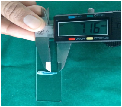
Apical root dentin translucency as a tool for age estimation in forensic odontology – A cross sectional study
Abstract
Forensic science is a multidisciplinary subject that involves scientific assessment of blood samples, DNA, bones and teeth. It plays an important role in criminal investigations, although it is equally used in other sciences like archaeology, anthropology, biology and geology also.1 Forensic odontology is a branch of forensic science which aids in identifying humans after homicides, accidents, wars or natural calamities, using information obtained from the structures of the oral cavity. In the absence of the usual forensic evidences like fingerprints, dental indicators become much more valuable in the identification process. Teeth can play a vital role in estimating age, sex, personal habits, systemic health, race, socioeconomic status, occupation and dietary status of an individual.2Age estimation is an important part of forensic sciences, and teeth are especially helpful in the age estimation process.3 Among the various dental age estimation methods in use today, factors like dentin color, attrition and periodontitis can be influenced by external forces and environment. Their role in age estimation becomes questionable when the teeth examined are affected by these factors. However, apical root dentin translucency is least influenced by them.2,4 Mineralisation apparently increases with advancing age. It is well accepted that, amount of translucent dentin increases with age and the expansion of translucency proceeds from the apical portion of tooth to the coronal portion.5,6 Therefore, measuring the amount of root dentin translucency can be useful as a tool for age estimation. Hence, we designed a study to determine the correlation between the chronological age and apical root dentin translucency and to assess whether apical translucency is a reliable method for age estimation of unknown.
Full Text:
PDFReferences
Richard Saferstein 4th ed. Pearson Education; 2011. Forensic science an introduction. https://www.pearsonhighered.com/assets/preface/0/1/3/4/0134806212.pdf.
Jain N. Tooth-A key aid in establishing identity of deceased individuals. Dentistry. 2012;3(2):1-3.https://www.longdom.org/open-access/tooth-a-key-aid-in -establishing-identity-of-deceased-individuals-2161 -1122.1000165.pdf
Rai B, Dhattarwal SK, Bhardwaj DN, Anand SC. Coronal displacement of cementum in impacted teeth: Age determination. World J Med Sci. 2006;1(2):117-118. https://pdfs.semanticscholar.org/8373/6bbd1208c63d63efc3df077bacf8602750ef.pdf.
Gupta P, Kaur H, Madhushankari GS, Jawanda MK, Sahi N. Human age estimation from Tooth cementum and dentin. J Clin Diagn Res. 2014;8(4):7-10. https://www.ncbi.nlm.nih.gov/pmc/articles/PMC4064910/.
Morse DR., Esposito JV, Schoor RS, Williams FL, Furst ML. A review of aging of dental components and a retrospective radiographic study of aging of the dental pulp and dentin in normal teeth. Quintessence Int. 1991;22(9):711-720. https://www.ncbi.nlm.nih.gov/pubmed/1946947
Singhal A, Ramesh V, Balamurali PD. A Comparative analysis of root dentin translucency with known age. J Forensic Dent Sci. 2010;2(1):18–21. https://www.ncbi.nlm.nih.gov/pmc/articles/PMC3009549/.
Solheim T. Dental root translucency as an indicator of age. Scand J Dent Res. 1989 Jun;97(3):189-97. https://www.ncbi.nlm.nih.gov/pubmed/2740830.
Miles AEW. Dentition in the estimation of age. J Dental Res 1963;42:255-63. https://journals.sagepub.com/doi/abs/10.1177/00220345630420012701.
Bang G, Ramm E. Determination of age in humans from root dentin transparency. Acta Odontol Scand. 1970; 28(1): 3-35. https://www.ncbi.nlm.nih.gov/pubmed/5265990.
Whittaker DK, Bakri MM. Racial variations in the extent of tooth root translucency in ageing individuals. Arch Oral Biol. 1996 Jan;41(1):15-9. https://www.ncbi.nlm.nih.gov/pubmed/8833585
Thomas GJ, Whittaker DK, Embery G. A comparative study of translucent apical dentin in vital and non-vital human teeth. Arch Oral Biol 1994; 39(1): 29-34. https://www.ncbi.nlm.nih.gov/pubmed/8179506.
Azaz B, Michaeli Y, Nitzan D. Aging of tissues of the roots of nonfunctional human teeth (impacted canines). Oral Surg Oral Med Oral Pathol. 1977;43(4):572-8. https://www.ncbi.nlm.nih.gov/pubmed/265484
Tencate AR, Antonio Nanci. 8th ed. Elsevier Publishers; 2008. Ten Cate’s Oral Histology,Development,Structure and Function. https://www.elsevier.com/books/ten-cates-oral -histology/nanci/978-0-323-07846-7.
Nalbandian J, Gonzales F, Sognnaes RF. Sclerotic age changes in root dentin of human teeth as observed by optical, electron, and x-ray microscopy. J Dent Res. 1960;39:598-607. https://www.ncbi.nlm.nih.gov/pubmed/14425932
Vasiliadis L, Stavrianos C, Dagkalis P, Parisi KS, Samara E. Root dentine translucency of human teeth : Factors affecting formation and deposition. Journal of Biological Science. 2011;6(2):82-88.
Vasiliadis L. Root dentine translucency. Ph.D.Thesis, Bristol University, UK, 1981.https://scholar.google.co.in/scholar?q=16.+Vasiliadis+L.+Root+dentine+translucency.+Ph.D.+Thesis,+Bristol+University,+UK,+1981.&hl=en&as_sdt=0&as_vis=1&oi=scholart.
Sivapathasundaram B, Rajendran R. Shafer’s textbook of oral pathology 6th ed, 2009. https://www.elsevier.com/books/shafers-textbook-of-oral -pathology-6-e/rajendran/978-81-312-1570-8.
Megyesi Ms, Ubelaker DH, Sauer NJ. Test of the Lamendian aging method on two historical skeletal samples. Am J Phys Anthropol. 2006;131:363-7. https://www.ncbi.nlm.nih.gov/pubmed/16617435.
Refbacks
- There are currently no refbacks.

This work is licensed under a Creative Commons Attribution-NoDerivatives 4.0 International License.
An Initiative of The Tamil Nadu Dr MGR Medical University
 University Journal of Surgery and Surgical Specialities
University Journal of Surgery and Surgical Specialities